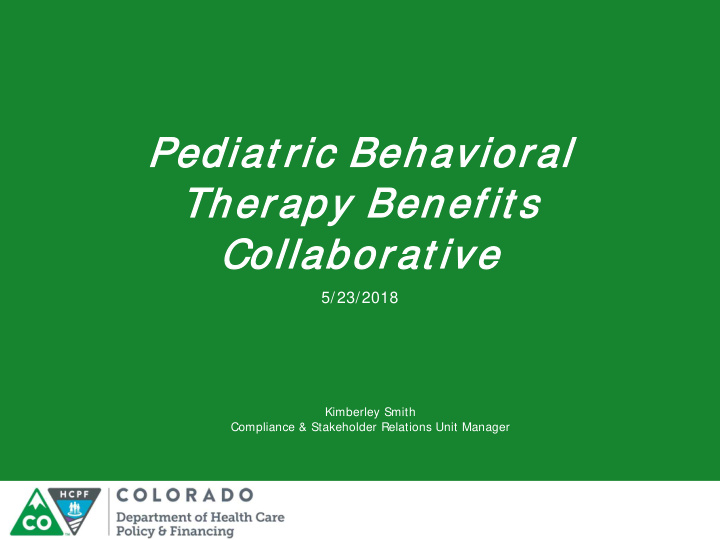



Pediat at ric Behav aviora oral Ther erapy Ben enef efit s Col ollab abora orat ive 5/23/2018 Kimberley Smith Compliance & Stakeholder Relations Unit Manager
Our Mis issio ion I mproving health care access and outcomes for the people we serve while demonstrating sound stewardship of financial resources
W hat i is t t he B Benefit s Collab llaborat at iv ive Process?
Objective Develop Benefit Coverage Policies • Subject matter experts draft a coverage policy according to evidence-based guidelines and best practices
What is a Benefit Coverage Policy? • Identifies what services are covered by Health First Colorado (Colorado’s Medicaid Program) • Defines the appropriate amount, scope and duration of a covered service • States determination of whether a given service is medically necessary • Describes the service • Lists who is eligible to provide and receive said service and where
W hat ’s M My Role H Here To Today ? ? How D Do I P Par art ic icip ipat at e?
Your Role Participants Are Consultants Your role is to provide suggestions for policy improvement based on: • Evidence based research and data • Peer reviewed literature • Knowledge of the population we serve
Guiding Principles Policy Suggestions Adopted Will : • Be guided by recent clinical research and evidence based best practices, wherever possible. • Be cost effective and establish reasonable limits upon services. • Promote the health and functioning of Medicaid clients.
Our Role • To seek out the feedback of the population we serve and those that support them. • To implement suggested improvements that meet the collaborative’s guiding principles. • To foster understanding in the community about how policy is developing, and why.
Ground Rules Participants Are Asked To: • Mind E-manners • Identify Yourself • Speak Up Here & Share The Air • Listen for Understanding • Stay Solution Focused • Stay Scope Focused
Pediat at ric Behav aviora oral Therap rapy Kimberley Smith – Compliance & Stakeholder Relations Unit Manager Gina Robinson– PBT/EPSDT Policy Specialist
Proposed Changes to PBT Policy • Create a new eligible provider type (BCaBA) that can provide and bill for services. • Improve quality, effectiveness, and consistency, of services. Learn from new PAR process questions rolled out 4/1/2018 Plan to hire degreed professional to review PARs and develop additional guidance for reviewers
Why create new eligible provider type? • Expand limited provider pool • National certification for BCaBA providers has grown
What is meant by improving quality, effectiveness, and consistency (QEC) of services? • Quality of current professional knowledge and standards applied to development and approval of care plans • Effectiveness of therapies as measured by outcomes and met goals • Consistency of access to quality services for children across the state
Improving QEC – New Provider Questions • Examples of questions added to the PAR process on 4/1/18 Has the child received behavioral therapy services from a different organization in the past 6 months? What screening tool was used to assess the need for behavioral therapy? • Examples of how these questions may help improve QEC Identify differences across providers and nature of client access issues Identify if certain assessment tools lead to more accurate assessments and outcomes
Improving QEC – Plan to hire degreed professional to review PARs • Degreed professional would: Review 50-100 previously approved PARs to assess them for quality of: care plan; goals w/in the plan and any previous plans; and the degree to which goals were met. Use information gathered to develop additional training and/or guidelines for PAR reviewing staff. • Example of how these actions may help improve QEC Reduce instances in which child is discharged by one provider for meeting care plan goals only to begin new care plan with different provider.
Questions for this group • Creating a new eligible provider type (BCaBA) Are there other mid-level provider types of which we are not aware and which we should consider including as eligible direct service providers? How do you anticipate the addition of this provider type will help your organization? Do you have concerns about the addition of this provider type?
Questions for this group • Addition of PAR process questions Are the questions added as of 4/1/2018 clear? Can your office answer the questions as written? Do you have additional question suggestions that may help us improve QEC over time? What advice would you give the Department about how to improve the QEC of services across providers? How do you monitor and improve upon quality?
Questions for this group • Hiring degreed professional to review PARs Do you have concerns about the hiring of a degreed professional to review PARs and to provide further guidance to PAR reviewers? If so, what are they? Do you have advice regarding what the degreed professional should be looking for when evaluating the quality of the care plan, the goals therein and whether those goals were met? If you were advising PAR reviewers, what guidance would you give them that may help to improve QEC over time?
Tha hank nk Y You
Recommend
More recommend